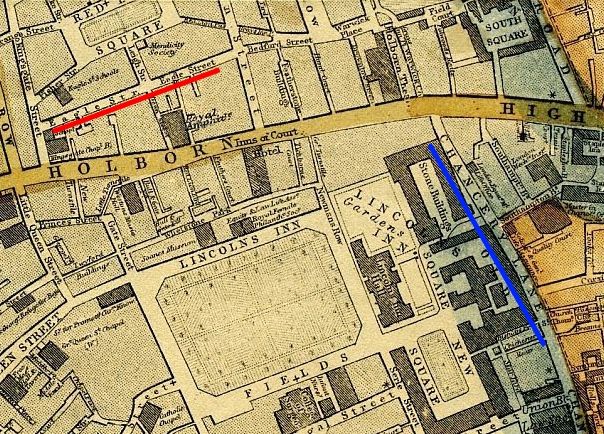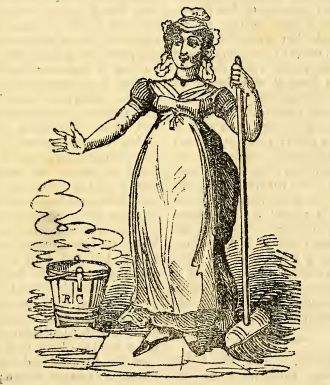Running parallel to, and lying between, High Holborn
and Red Lion Square in London is Eagle Street. In 1815, Eagle Street was
narrow, dark, dirty lane of cheap flophouses and cheaper shops. There was a
bird-stuffer’s establishment, a marine chandler’s place, rag and bottle shops,
vendors of tripe and cats’ meat, broadsheet sellers offering farthing prints,
shoddy sellers and tawdry merchants. At the end of July, in amongst this gloomy
aggregation of penny-pinching poverty and grim grime, in the back room of
number 14 Eagle Street, the parents of Elizabeth Fenning placed the executed
body of their daughter, who had been hanged at Newgate Prison.
 |
| Eagle Street underlined in red |
Her father,
William, had been promised that the body would be returned to him after the
execution but he was shocked when he was told that he would have to pay
fourteen shillings and sixpence for the executioner’s fees before the body
would be released. He pawned the family furniture and clothes and borrowed the
rest of the money to raise the amount he needed and when sympathisers and the
curious descended on Eagle Street and began to leave unsolicited donations with
the bereaved old soldier, the police intervened and stopped people from
knocking on the house door.
On July 31st, the funeral procession
left Eagle Street, surrounded by an enormous police presence, as eight mourners
led by Elizabeth’s parents and six maiden pallbearers clad in white walked
slowly to St George the Martyr’s burial ground. The streets were lined with
people and 10,000 people attended the committal, and all without incident. The Observer
newspaper raised a subscription from its readers for the benefit of the
bereaved family. It was widely believed that Elizabeth Fenning was innocent and
had been wrongly hanged.
 |
| Elizabeth Fenning |
William Fenning had served abroad with the Suffolk
regiment and his wife bore ten children, all of whom bar one had died in
childhood. After completing his military service of almost twenty years,
William moved to London and began a potato dealing business with his brother in
Red Lion Square. His only remaining daughter, Elizabeth, entered domestic
service when she was fourteen years old, and in late January 1815, at the age
of twenty-one she obtained the position of cook to Mr Robert Gregson Turner and
his wife, Charlotte, at 68, Chancery Lane.
 |
| Chancery Lane underlined in blue |
The house belonged to Orlibar
Turner, a law-stationer and father of Robert, who lived at Lambeth and who came
to dinner on March 21st. They dined on beefsteak pie, potatoes and
yeast dumplings, and soon after eating all three Turners became violently ill,
vomiting and suffering chest and stomach pains. Fenning had made yeast
dumplings on the day before, which had been white, fluffy and delicious but the
dumplings she made on the next day were heavy and dark coloured.
One of two
teenaged apprentices who lived in the household, Roger Gadsden, went into the
kitchen and ate a piece of a dumpling about the size of a walnut together with
some gravy that he mopped up with bread, and soon after he fell ill too.
Elizabeth Fenning also ate some of the meal, and when Doctor John Marshall, who
had been sent for, arrived at the house, he found her collapsed and vomiting on
the staircase. The other apprentice, Thomas King, and Sarah Peer, a
maidservant, had dined earlier and did not become sick; they had eaten some of
the pie but not the dumplings.
Orlibar Turner and Dr Marshall suspected poison,
and an examination of a serving dish revealed some white residue in the bottom
which, when tested, was shown to be arsenic. Turner kept a quantity of arsenic
in a drawer in the house, which was used to kill mice that damaged the
parchments and legal papers he kept in store, and it was found to be missing.
Marshall tested the remains of the dumplings and they were laced with arsenic
and so Fenning, who had made them, was arrested and charged with attempted
murder.
At the trial, Mrs Turner gave evidence that she had admonished Fenning
for going ‘partly undressed’ into the apprentices’ bedroom and
afterwards the girl had been sullen and disrespectful. It was stated that the
arsenic powder, kept in a paper and marked ARSENICK DEADLY POISON in large
letters, had been seen on March 7th but had then gone missing, it
was kept in a drawer that was left unlocked during the day, and that Fenning
would take paper from this drawer with which to light the fires.
 |
| Trial of Elizabeth Fenning - Old Bailey Proceedings |
When called to
the stand, Fenning gave a different version of events; she had gone into the
apprentices’ room to get a candle and Gadsden had taken a ‘liberty’ with
her, which accounted for the state of undress that her mistress had seen. She
did not take paper from the drawer herself but always asked Thomas King for
paper with which to light the fires but the recorder of the court would not
allow King to give evidence to support her claim. The recorder also disallowed
character statements from some witnesses and refused to allow her father to
speak in court. There were a number of other anomalies and inconsistencies
during and after the trial, which make this a particularly interesting case and
I’ll look at these in more detail tomorrow.
No comments:
Post a Comment